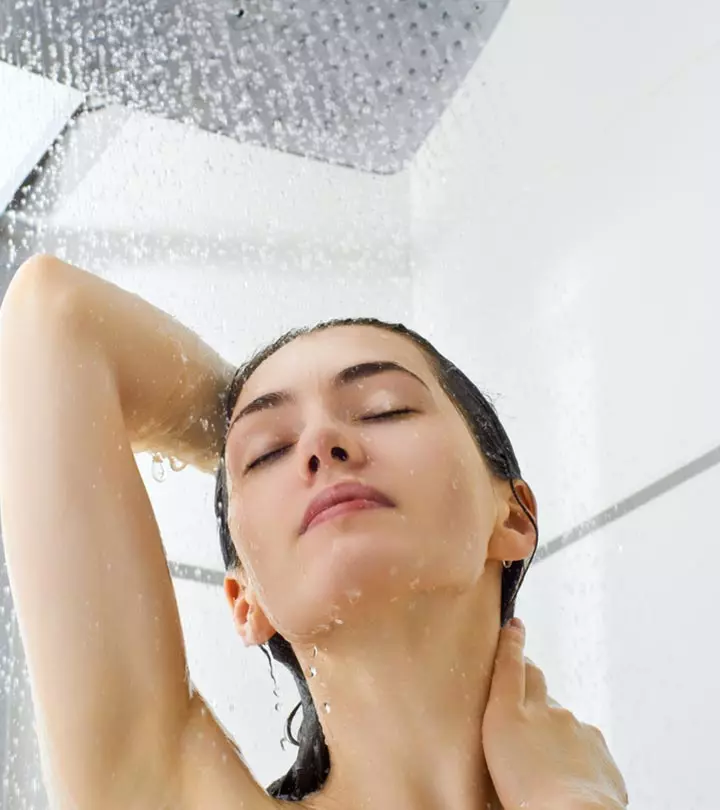Sodium Lauryl Sulfate For Skin: Benefits And Best Way To Use
Remove your makeup with ease with the help of this popular surfactant.

Image: Shutterstock
There is a common belief that sodium lauryl sulfate (SLS) deteriorates skin health and causes skin discomfort and irritation. So, people in beauty circles often advise avoiding products with sodium lauryl sulfate for skin safety. SLS is one of the most misunderstood and vilified cosmetic ingredients.
But does it harm your skin? Is there any truth behind these beliefs? Let us try to find out it in this article. Scroll down.
 Know Your Ingredient: Sodium Lauryl Sulfate
Know Your Ingredient: Sodium Lauryl SulfateWhat Is It?
A surfactant often sourced from palm kernels or coconut oil that is used in cosmetic and cleaning products.
What Are Its Benefits?
Helps remove makeup and dirt as a cleaning agent.
Who Can Use It?
Generally safe for use for all skin types.
How Often?
Regularly.
Caution
Can cause allergic reactions in people with sensitive skin or preexisting skin issues.
In This Article
What Is Sodium Lauryl Sulfate (SLS)?
Sodium lauryl sulfate is a surfactant and a cleaning agent often used in cosmetics and cleaning products (1). It is either derived from natural sources like palm kernel and coconut oils or manufactured in a laboratory. It is also known as sodium dodecyl sulfate. It is a common ingredient in toothpaste, shampoos, bath gels, detergents, and floor cleaners.
 Did You Know?
Did You Know?We are now aware that SLS is a useful ingredient. But does it have any actual benefits for the skin? Read to know.
Key Takeaways
- Sodium lauryl sulfate (SLS) is a common ingredient in cosmetics and cleaning products.
- It helps cleanse your skin effectively, remove makeup, fight bacteria, and make skin more permeable.
- However, prolonged exposure to SLS may cause nausea, redness, irritation, dryness, and skin damage.
How Can Sodium Lauryl Sulfate Benefit Your Skin?
SLS is a multi-purpose ingredient known for its numerous uses. Contrary to popular belief, it can be beneficial to your skin in a few ways.
1. Works Up A Rich Lather

SLS is known for its ability to lather up beautifully. It gives you the soothing sensory pleasure of a luxurious lather. A creamy lather also helps cleanse your skin better by drawing out the dirt and oils.
2. Promotes Effective Cleansing

The suds built up by SLS clean your skin more effectively and give you a “squeaky” clean feeling. You can work up a fluffy cloud of soft, cleansing bubbles with just a few drops of the cleansing product.
3. Helps Remove Makeup

Removing stubborn makeup is a major challenge. As per anecdotal evidence, using a facial cleanser with SLS makes makeup removal effortless. The suds help break down the residual makeup on your face and make it easier to wash off.
4. May Fight Bacteria
Many beauty vloggers claim that the anti-bacterial and anti-microbial properties of SLS might protect your skin from certain harmful microorganisms. However, scientific research is warranted in this regard.
5. May Make Skin More Permeable
As per anecdotal evidence, topical application of SLS deep-cleanses your skin and makes it more permeable. It also may allow the skin to better absorb nutrients and moisture from the skin care products you apply later.
These are the purported benefits of SLS. It is interesting to observe that most individuals tend to confuse SLS with SLESi A compound commonly found in rinse-off products, and is highly effective in cleaning, emulsifying, and creating foam. (sodium laureth sulfate). How are the two different?
Sodium Lauryl Sulfate (SLS) Vs. Sodium Laureth Sulfate (SLES)
SLES is also a great surfactanti Chemical compounds that reduce surface tension and let liquids spread on wet surfaces; they enable soaps to dissolve in water. used for the same purposes as SLS. But they are quite different in certain aspects.
SLS is the parent chemical SLES is derived from (through a process called ethoxylation, where ethylene oxide is introduced). SLES is considered safer than SLS and is more often used in personal care products. It is believed that SLS may irritate the skin a lot more than SLES. SLS is also thought to dissolve proteins in the tissue, unlike SLES.
While many beauty bloggers are against the idea of using SLS on your skin, you can’t deny that working up a rich lather feels soothing and comforting. If you don’t have any underlying skin condition and your skin is not too sensitive, you can get the best out of SLS. Here’s how.
What Is The Best Way To Use Sodium Lauryl Sulfate On Your Skin?
SLS, in general, has a bad reputation for causing skin sensitivity. But there is no harm in using products with this ingredient as long as your skin is not too sensitive. Do ensure you use the product in an optimum way to minimize the chances of skin irritation.
Here’s the best way to use SLS on your skin:
1. Thoroughly Wet Your Skin
Thoroughly wet your skin with cool or lukewarm water before applying any product with SLS. Using a surfactant or a foaming agent on dry skin is likely to irritate it. If you are using a liquid bath gel, dilute it with a little water before use.
2. Work Up A Rich Lather
One of the most appealing qualities of SLS is its ability to lather up nicely. Once your skin is thoroughly wet, use your cleansing agent to work up a rich lather with a little water. Take care to use this lather only in your armpits, and on your torso, legs, and feet. Avoid using products with SLS on your facial skin or the delicate skin on your genitals.
3. Rinse Off Thoroughly
Once you have thoroughly cleaned your body, rinse off all the lather with fresh, flowing water. Ensure no suds remain on your skin. Towel dry.
4. Moisturize

SLS tends to strip off your skin’s oils. Your skin is likely to feel drier after a bath. Apply a moisturizing body lotion on your arms, legs, neck, and shoulders immediately after towel-drying yourself to restore some of the lost moisture.
 Quick Tip
Quick TipWhile bath products with SLS are generally considered safe for daily use, do not let the ingredient stay in contact with your skin for long. Long-term exposure to SLS may lead to certain unpleasant side effects.
What Are Some Potential Side Effects Of Sodium Lauryl Sulfate?

Scientific research is warranted to substantiate most of the negative effects of SLS. However, anecdotal evidence does state these potential side effects of SLS:
- Long-term ingestion of SLS may cause kidney and liver damage. It is claimed that SLS gets absorbed into the bloodstream through the skin and gets built up in kidneys or liver. However, research does not support this.
- SLS may increase cancer risk when used in conjunction with certain other chemicals. But there is no evidence to support that SLS is a carcinogen.
- Penetration of SLS into the eyes can cause severe redness and irritation.
- Shampoos with SLS may hinder the hair growth cycle and prolong the hair loss phase.
- It may compromise the skin’s natural barrier, potentially causing increased sensitivity and irritation if overused.
- Prolonged exposure of SLS to skin may cause excessive dryness and skin damage.
A blogger shared their experience of using products with SLS for their skin. They said, “I did have one experience, where I was using an exfoliant containing SLS. It literally dried out my skin so much and has, one way or another, contributed a little in making my skin sensitive (i).”
- It may cause nausea and vomiting if ingested.
- It does not degrade easily and stays in the environment for long when washed down the drain.
Now that you are aware about the pros and cons of SLS, you can make an informed choice about its use. Here are a few products likely to contain SLS.
Which Types Of Products Contain Sodium Lauryl Sulfate?
SLS is a very common ingredient found in numerous personal care and home care products, owing to its properties as a surfactant and an effective cleaning agent.
SLS is usually present in the following products:
- Soaps
- Hand washes
- Facial cleansers
- Body washes
- Makeup removers
- Toothpaste
- Shampoos
- Dishwashing liquids
- Laundry detergents
 Quick Tip
Quick TipClosing Thoughts
Sodium lauryl sulfate (SLS) is a recognized skin irritant. However, you do not need to avoid SLS unless you have sensitive skin. To reduce the chances of skin irritation, make sure you use the SLS-containing products properly. Because of its capabilities as a surfactant and a powerful cleaning agent, SLS is a popular ingredient in a wide range of personal care and home care products. Enjoy a relaxing warm bath or a shower with body cleansers containing SLS as long as you follow up with a hydrating moisturizer. However, if you have dry or sensitive skin, look for SLS-free products.
Infographic: Top Benefits Of Sodium Lauryl Sulfate For Skin
While sodium lauryl sulfate does harm the skin, it also provides it with many benefits. Scroll down to the infographic below to read through its top benefits, so you can weigh out the good and bad and make an informed decision of whether to add this ingredient to your routine. Check it out now!

Illustration: StyleCraze Design Team
Frequently Asked Questions
Is it safe to use sodium lauryl sulfate on the skin daily?
No, sodium lauryl sulfate can be harsh on the skin, potentially causing dryness or irritation with daily use, especially if you have sensitive skin.
Does sodium laureth sulfate clog pores?
Sodium laureth sulfate may clog pores, especially if you have sensitive skin.
Is sodium laureth sulfate good for acne?
No, SLS is not recommended for acne issues as it is known to cause skin inflammation and aggravate breakouts.
Does sodium lauryl sulfate cause skin allergic reactions?
Yes, SLS may cause skin allergic reactions such as irritant contact dermatitis, especially in sensitive skin.
Why is sodium lauryl sulfate banned?
The European Union has banned the use of SLS as a food additive. However, because of its ability to remove oil and grease, it is frequently used as a cleaning agent in a variety of personal care products.
Is sodium lauryl sulfate a paraben?
No, parabens are preservatives used in cosmetic products to stop the growth of bacteria and fungi. Sodium lauryl sulfate is a sulfate also referred to as a detergent or surfactant in consumer products. It binds to oil, grease, fat, and grime to remove them from the surface.
Sodium lauryl sulfate is a common ingredient used in many skin care products, but is it really bad for your skin? Dive into this video to find out more about how it affects your skin.
Personal Experience: Source
StyleCraze's articles are interwoven with authentic personal narratives that provide depth and resonance to our content. Below are the sources of the personal accounts referenced in this article.
i. Dealing With T-Zone and Dry Cheekshttps://myorganicjourney11.blogspot.com/2013/10/dealing-with-t-zone-and-dry-cheeks.html
References
Articles on StyleCraze are backed by verified information from peer-reviewed and academic research papers, reputed organizations, research institutions, and medical associations to ensure accuracy and relevance. Read our editorial policy to learn more.
- Human and Environmental Toxicity of Sodium Lauryl Sulfate (SLS): Evidence for Safe Use in Household Cleaning Products
https://www.ncbi.nlm.nih.gov/labs/pmc/articles/PMC4651417/
Read full bio of Dr Jovana Majstorovic
Read full bio of Arshiya Syeda
Read full bio of Ramona Sinha
Read full bio of Shiboli Chakraborti
























Community Experiences
Join the conversation and become a part of our empowering community! Share your stories, experiences, and insights to connect with other beauty, lifestyle, and health enthusiasts.